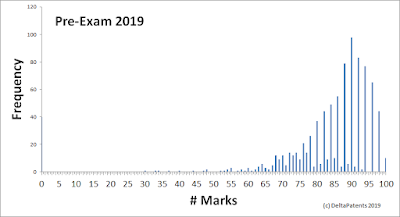The Pre-Exam 2019 results are out! They can be found
here.
In the list, results for the pre-examination of the European qualifying examination 2019 are listed according to the EQE Registration Number (EQEReg).
The list also indicates that dispatch of the result letters is foreseen for 18 March 2019. Only results as
notified to the candidates in the results letter are binding.
Pass rate
If my tools and myself did not make any errors, I come to a very high pass rate:
920 candidates enrolled
107 scored 0-69, 813 scored 70-100, so: 11,6% fail and
88,4% pass of all that enrolled.
880 candidates actually sat the exam. of these:
67 scored 1-69, 813 scored 70-100, so: 7,6% fail and 92,4% pass of all sitters.
Scores varied from 30 to 100. 10 candidates scored 100 out of 100; 383 scored 90 or more.
149 candidates that failed in 2018 enrolled for this year's exam; of these, 139 sat the exam, and scored in a range of 40 - 94 marks. Of the ones that sat, 84,2% passed (78,5% from those that enrolled).
Congratulations to all who passed!
Examiner's Report
The Examiner's Report is also available (
here).
Our answers (
legal and
claims analysis) would have attracted full marks.
(Only) Statements 19.1 and 19.2 were
neutralized. For 19.1 and 19.2, the arguments given in the Examiner's Report is:
Claim A.1 results from the combination of claims 1 to 4 as originally filed, and the feature of paragraph [003] last sentence. Claim A.2 is based on the combination of claims 5 and as originally filed. Therefore, the statements 19.1 and 19.2 are True.
However, there is a potential difference in scope between the wording in the description(e.g. paragraph [003] last sentence) and the wording of claim A.1 (“pass through” vs.“extending through”) in the English version. Also there may be valid counter-arguments inview of an un-allowed intermediate generalization. For this reason it was exceptionallydecided to award marks for both answers, True and False, for the statements 19.1 and 19.2.







